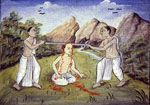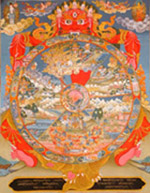
Among the world's religions, people have three principle models for reaching the sacred: prophets, shamans, and sages. Like Moses or Mohammad, prophets are divinely inspired, and their personal experience of the divine often allows them to speak for their God to a larger community of faith. Shamans are men and women who enter trance states to communicate with supernatural beings-gods, demons, ghosts. Sages find a deepened insight into the nature of reality through ascetic and meditative practices. Prophets, shamans, and sages often have remarkable or supernatural experiences and they perform actions that create well-being for others.
Siddhartha Gautama, the Buddha, was a person who embarked on a personal quest to understand the meaning of life. After much suffering, severe tests, and many trials, he achieved insight into the nature of reality through meditation. Once he attained enlightenment, he spent his life teaching others the path he followed to free himself from the cycle of life and death. While you might not think to group the Buddha with Odysseus or Spiderman, he shares with both the goal of relieving people of their suffering and restoring them to a state of real rather than illusory happiness and contentment.
Journal

Enlightenment
Journal

Fables
Myths
Parables
Journal
Be prepared to discuss the tales and how fables, myths, and parables construct a story for a particular purpose and audience.

Life
Death
Heaven
Hell
Journal
Reading
Read the following selections from Words of My Perfect Teacher.
To understand the workings of karma, actions and their effects, read pages
101-102. Read pages 72-73 to visit one of the six realms, the realm of
the pretas, or hungry ghosts. Read pages 117-118 to learn positive actions
that accrue merit. Learn about the Wheel of Life in one of the following
three ways. Enlarge the Wheel of Life above and use this diagram
to familiarize yourself with the different sections and symbols. To read
a longer explanation, click
here. To visit an interactive Internet introduction to the Wheel of
Life, click here.
Be sure you understand: karma, samsara, rebirth, the three cardinal faults,
the six realms, and the twelve interdependent elements that cause misery.

Now you have enough general background to begin to understand why the Buddha had previous lives and what value they might have for understanding his life and teachings.
Jataka tales are stories that demonstrate various good
actions that can lead to release from samsara. We'll begin by reading
one tale together and several in groups. As you'll see from your copy
of the "Katkkata-jataka," "The Crab Jataka," Jataka
tales have a common format. Each tale is introduced with a short explanation
of the time, place, and circumstances surrounding the telling of the
story. The Buddha then proceeds to tell the story. The tale concludes
with a verse proclaiming a moral precept. At the end, the Buddha explains
the symbolism of the tale.
Tomorrow we will read a traditional version of "The Crab Jataka"
and a contemporary adaptation of The Rabbit and the Tigerdile.
Afterwards, we will read several other Jataka tales in groups and present
them to the class as one act plays.
Jataka Tales
Reading
Illustrated Manuscript
Group Project
Use this link for a model to base your manuscript upon.
Your project should satisfy the following requirements:
1) Your tale should have an illustrated title page, 2) it should contain six to eight pages of text, 3) even though an original page would be 4" x 26", your pages should be 4 ¼" x 11", 4) each page should have a uniform border and one or two illustrations, 5) illustrations should match the narrative, 6) narrative passages should average 50 to 100 words per page, 7) they should be well-written, carefully edited, and appropriate for a third grade reader, and finally 8) the manuscript should state the occasion, tale, verse, and symbolism.
For extra credit: Make a posterboard or cardboard upper and lower cover for your jataka tale. You will find examples at www.asianart.com/exhibitions/covers/index.html.
Once the Buddha Was A Monkey: Arya Sura's Jatakamala. Translated
by Peter Khoroche. Chicago, IL: University of Chicago Press, 1989.
The Rabbit and the Tigerdile. W. W. Rowe. Ithaca, NY: Snow Lion
Publishers, 1996.
Stories of the Buddha. Translated by Caroline A.F. Rhys Davids. New
York, NY: Dover Publications, Inc., 1989.
Twenty Jataka Tales. Retold by Noor Inayat Khan. Rochester, VT:
Inner Traditions International, 1985.
Words of My Perfect Teacher. Patrul Rinpoche. Translated by Padmakara
Translation Group. Walnut Creek, CA: Altamira Press, 1998.
http://www.accesstoinsight.org/lib/bps/leaves/bl135.html
http://www.buddhistinformation.com/american_jataka_talesno_1.htm
http://www.buddhanet.net/e-learning/buddhism/budtale1.htm
